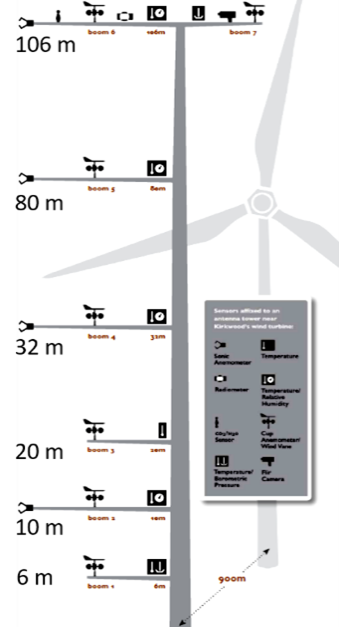Background and significance.
Wind profiles quantify the available incoming kinetic energy of the wind and its potential for wind power generation. A modern wind turbine can be several hundred meters tall above the earth’s surface: at the Danish National Test Center Vestas V164 wind turbine has a rotor diameter of 164 m, and a hub height of 200 m [1]. Wind velocities are often measured using meteorological towers mounted with various anemometers at fixed elevations and then extrapolated using models to characterize the wind profile up to the height of interest. The wind shear exponent α of the common power-law model varies in a wide range depending on the surface terrain and atmospheric stability [2]. However, the recommended α values in wind engineering do not take the thermal stability into account [3]. This project will analyze the wind shear exponents as a function of surface terrain (onshore, offshore) and atmospheric thermal stability classes (unstable, neutral, stable and strongly stable conditions). We will use two unique, representative wind datasets: 1) one-year 106-m meteorological tower data (Fig.2) at Cedar Rapids Iowa [4], and 2) one-year 50-m meteorological tower data 3 miles offshore in Lake Erie (Fig.5).

Figure 2: 106-m met- tower with wind sensors at Cedar Rapids Iowa for wind resource assessment.
REU student involvement.
REU students will learn met-tower sensor installation, cup- and sonic anemometer capabilities/limitations, analyze time- series of wind speed using Matlab and R programming based on the surface terrain and thermal stability classification. Specific power-law exponent models will be developed for wind power generation at Iowa (in land) and Lake Erie (offshore) wind turbine sites.
References.
1. P. Veers, K. Dykes, E. Lantz, S. Barth, C. L. Bottasso, O. Carlson, A. Clifton, J. Green, P. Green, Holttinen et al., “Grand challenges in the science of wind energy,” Science, vol. 366, no. 6464, 2019.
2. G. Gualtieri, “A comprehensive review on wind resource extrapolation models applied in wind energy,” Renewable and Sustainable Energy Reviews, vol. 102, pp. 215–233, 2019.
3. A. Kareem and Y. Tamura, Advanced structural wind engineering. Springer, 2013, vol. 482.
4. M. Vahidzadeh and C. D. Markfort, “Modified power curves for prediction of power output of wind farms,” Energies, vol. 12, no. 9, pp. 1–19, 2019

